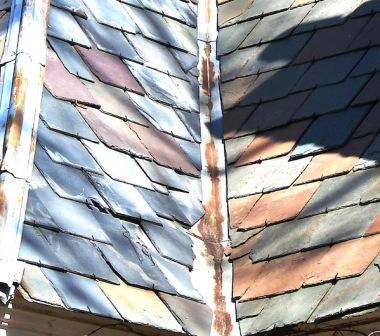Mastering Roof Inspections: Slate Roofs, Part 10
by Kenton Shepard and Nick Gromicko, CMI®
The purpose of the series “Mastering Roof Inspections” is to teach home inspectors, as well as insurance and roofing professionals, how to recognize proper and improper conditions while inspecting steep-slope, residential roofs. This series covers roof framing, roofing materials, the attic, and the conditions that affect the roofing materials and components, including wind and hail.

Damaged Underlayment
Repairs are evidence of past problems. It’s common for underlayment to be torn during repairs but uncommon for that underlayment to be repaired, so look for signs of leakage below any repairs you find.
It’s possible that the roof leaked before the repair was made, so stained materials should be tested with a moisture meter for elevated moisture levels.
If there’s been no recent rain or snow in the area, the stain may be dry even if the roof still leaks, so if you find normal moisture levels when you test, you should mention in your inspection report that you tested but the results may be inconclusive because the weather was dry during the days or weeks before the test.
Leaking Slate Roofs

Regarding moisture and roofs, there are two general rules to keep in mind:
- Water always moves downhill. Steeper slopes move water off the roof more quickly, which reduces the chance of them developing leaks.
- Water always takes the path of least resistance. Water runs more quickly across smooth surfaces. Roof components and debris that hamper its progress will slow the water down, increasing the chance of the roof developing leaks. Look for anything that blocks or impedes the water’s path of travel off the roof. Chimneys placed at the base of valleys are not uncommon.
Just as with other roof-covering materials, there is often more than one way to install slate roofs correctly. When you inspect the installation, check to see if the slates and flashing were installed using a method that keeps moisture from penetrating the roof, and in a way that will not cause premature failure.
These are all areas you should look at closely during an inspection:
- Roof penetrations should be flashed in a manner that will prevent leaks.
- Slates should typically have at least a 3-inch headlap. Installations that rely on interlaid underlayment to prevent leaks have a high chance of premature failure.
- Ridges, hips and valleys should have slates that fit together tightly. In high-quality installations, each pair of cap slates will have been cut from the same tile so that the color and grain match.
- Headwalls should have flashing that is installed behind the exterior wall-covering material and that overlaps the slates in the uppermost course.
- Sidewalls should have step-flashing in which each piece laps over the slate in the course below and is overlapped by the slate in the course above. Changes in pitch should have flashing installed.
- Roof edges should have edge metal installed, although it’s not required by most building codes.
- Ice dams can be a problem in cold climates. Efforts to remove the ice are likely to cause more damage than the ice itself. The ice dam is most likely to cause damage from pooling meltwater leaking down through the slate and underlayment and penetrating the roof assembly. Improving attic insulation can help. Sometimes, slates over the eaves are removed and replaced with metal roofing.
- Protruding fasteners can eventually wear through the overlying slate or cause the slate to split.
- Penetrations, such as plumbing stack vents, skylights and chimneys, can be difficult to retrofit and require a higher-than-usual degree of skill on the part of the installer. For this reason, they have an increased chance of leaking.
- If slates are split along the starter course, look to see if cant strips were installed as they should have been. Missing cant strips may cause slates in the starter course to crack.
If the roof appears to be in good condition, leaks may also be from the masonry. If through-wall flashing has not been installed, heavy rains may cause moisture to migrate through masonry.
Insects
It’s not unusual for insects or bats to live in a slate roof, especially roofs with heavy slate. Insects may sting and bats can transmit rabies, so be careful. Since you will probably not walk the roof, these pests my be difficult to spot. You may see insects during their normal daily activities, but bats are seldom seen unless they’re disturbed.
Chattering
Slates hung on steep roofs may rattle in the wind, and the noise they make is referred to as chattering.
**************************************************
Learn how to master a roof inspection from beginning to end by reading the entire InterNACHI series: Mastering Roof Inspections.
Take InterNACHI’s free, online Roofing Inspection Course
Mastering Roof Inspections
Roofing Underlayment Types
Inspecting Underlayment on Roofs
Fall-Arrest Systems
Roofing (consumer-targeted)
More inspection articles like this

